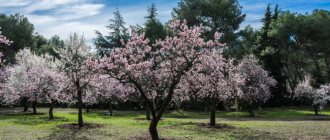Liriodendron, despite its decorative value, is not yet a frequent guest in our gardens. This beautiful flowering deciduous tree is just beginning to be used as a decoration in landscape design.
The plant is a relative of the magnolia and a member of the oldest lineage of angiosperms. The botanical name comes from the Greek words leirion - "lily" due to the shape of the flowers and "dendron" tree.
The genus has two species: the American tulip tree (Liriodendron tulipifera L.) and the Chinese tulip tree (Liriodendron chinense (Hemsl.) Sarg.).
In the culture of the middle zone, the popularity of the American native is gradually growing, since this particular species is highly decorative with its magnificent flowering. Young plants require attention, but older plants do well with minimal care.
Botanical description
Liriodendron is a large deciduous plant with a taproot system. Adults reach a height of more than 50 m. The crown width sometimes exceeds 1.5 m.
The trunks are massive, straight, without branches, and have greenish-gray smooth bark. With age, it becomes covered with frequent shallow grooves. The side shoots are located at an acute angle, far from the trunk. Young branches are brownish in color, smooth, covered with a thin waxy coating. From the first years of life, trees have a neat pyramidal crown. With age, it expands and becomes spreading.
Lyran leaves are large, four-lobed, with a notched top . Their size reaches 20 cm in length and 14 cm in width. The surface is smooth, with thin feathery veins. They are arranged alternately on the branches, hanging on 7-centimeter cuttings. The leaves are light green, sometimes with bright yellow stripes.
Liriodendron flowers are single, regular cup-shaped, 6–8 cm in size. They look like tulip buds. The petals of the corollas are slightly elongated, with smooth edges, the lower ones are bent down, the upper ones are raised. The color of the flowers is soft yellow, in some varieties cream. The petals are greenish at the base and have a bright orange edge in the middle part. Stamens are numerous, elongated, yellow.
The leaves and flowers of the tulip tree emit a light, cucumber-like, sweetish aroma.
Brown, cone-shaped fruits, about 5 cm in diameter, are formed in place of fading flowers, have a wide base and numerous lionfish with seeds. After ripening, they break off and are carried by the wind, sometimes remaining on the branches until next spring.
In its natural environment, the tulip tree prefers to grow on drained, breathable soils, sufficiently nutritious, with a high content of humus. The lifespan of a lyran reaches 450–500 years .
The high decorative qualities of the tulip tree served as the reason for its introduction to Europe. Initially they were planted only in the subtropics, then they began to grow in temperate latitudes. Most specimens tolerate frosts down to -35°C well; mature trees are quite drought-resistant.
Growing at home
You don’t have to be afraid to cultivate the North American tulip tree in open ground. With proper care, it takes root well. This plant is also suitable for growing as an indoor bonsai plant.
Lyriodendrons grow 80–100 cm per year . Adults have a massive, wide, dense crown, so the tulip tree must be placed away from buildings and fences. It is suitable only for owners of large plots. In small gardens this plant will be very cramped; the wide crown will drown out other crops over time. It is better to grow lyran in the sun or partial shade.
Landing
The soil should be fertile and loose. Black soil must be added to the depleted soil; too heavy clay soil must be diluted with peat and sand. The acidity of the soil does not matter, but lyriodendrons cannot tolerate large amounts of lime in the soil.
Planting is done in the spring, before the buds open . This should be done in soil heated to 12°C. The hole must be dug within a few days. Its volume should exceed the diameter of the seedling's earthen ball by 2 times. If you plan to plant several specimens, holes are dug at a distance of 5 m from each other. A drainage layer of small stones is placed at the bottom of the holes, and a mixture of soil and complex mineral fertilizer is poured on top.
The root of the seedling is removed from the container along with a lump of earth . It is recommended to moisten it first. When placing a plant in soil, the root collar should be flush with the surface. The soil is carefully compacted and watered. For 1 tree there should be about 15 liters of water. The tree trunk circle is mulched with peat, last year's grass or leaves in a layer of at least 8 cm. This will serve as good protection against drying out and cracking of the soil.
This plant is rarely grown by seeds . Sprouts sometimes appear after 2 years. Considering the rapid loss of germination, they may not be expected at all. Stratified seeds are placed in containers with a soil mixture of garden soil, sand and peat to a depth of 1 cm. It will take several months to moisten the soil and weed out the weeds. In summer, it is advisable to take the planting boxes out into the fresh air. When the emerging seedlings reach 30 cm, they are moved to open ground.
It is important to remember that the tulip tree does not tolerate transplantation, because its roots easily break under mechanical stress.
Reproduction methods
To propagate tulip magnolia at home, you need to know certain rules and, of course, be patient. There are several methods of reproduction:
Seeds
Liriodendron is propagated by seedlings. This process is not easy, and therefore requires knowledge and skills. It is almost impossible to grow a tree from a seed yourself, but if you want to try, the seeds should not be more than two days old. Such seed material is found in the fruits that have fallen after flowering.
Seeds should be sown in late autumn in a container with loose soil, then stored in a cool, damp place until spring.
An excellent option would be a basement, the temperature in which does not exceed +10 degrees. In April, the box should be placed in a sunny place. Very few seeds will germinate, approximately 5-15%. You don’t have to throw away the soil, put it in the same box in the basement, and in a year the same number of seeds will sprout in it. During this period, the seedlings should be watered moderately.
In May-June, cuttings that have grown to a height of 15-20 cm should be planted in small separate pots. A year later in the spring, they can be transplanted into open ground or a pot for growing indoors. If it is not possible to plant the plant outside, then the trees must be transplanted into a larger container for further growth and development. They can be left to grow in a flowerpot for another year until you decide on a place for permanent cultivation in open ground (the tree does not like and does not tolerate replanting).
Liriodendron begins to bloom after 11-15 years, by which time the perennial reaches a height of 6-9 m.
Cuttings
The most convenient and easiest way to propagate lyriodendron. At the beginning of the first summer month, young cuttings need to be cut. They quickly take root in containers with planting mixture without additional growth stimulants. The roots of the cuttings are fleshy, thick, but also very brittle. It is better to take deep pots for growing so as not to resort to frequent transplants.
There is no need to rush into planting in open ground: it will take a couple of seasons to form a strong root system of the seedling. A young tree should be replanted by transferring it from a pot to a planting hole in a permanent place, while trying to preserve the earthen lump at the roots.
Vaccination
To preserve the varietal qualities of lyriodendron, a vegetative propagation method is used - grafting. This procedure involves connecting the rootstock to the graft shoot. By merging, they form a single organism. It is recommended to graft as close to the root system as possible. Typically, rhododendron plants aged 3 to 5 years serve as rootstocks.
Material for winter vaccination is prepared in advance. In the fall, before frost sets in, the plant must be dug up and planted in a container. A container with a rootstock, the diameter of which should be 10 millimeters, is placed at home or in a greenhouse at a temperature no higher than +10 degrees. Before grafting, two weeks before, the rootstock should be watered abundantly. Annual shoots from 5 to 10 cm long are used as scion. They are cut in advance and placed in water before grafting.
The most favorable time for the vaccination procedure is the beginning of April.
Gardeners use two grafting methods - in the cut and in the butt. The grafted area is bandaged. Place a plastic bag over the plant and tie it tightly at the base. The plant is placed on the windowsill, where the temperature should be no lower than +18 and no higher than +22 degrees. After about 6 weeks, the buds swell and the polyethylene is removed. The rootstock must be reduced by half.
With any type of grafting, it is important to maintain cleanliness and accuracy, use sharp instruments, and properly care for the grafted lyriodendrons.
By layering
Not the most popular method of propagating a tulip tree. In autumn, when the plant has dropped its leaves, the shoots are bent to the ground and pinned. The pinning area is sprinkled with soil, only the tops of the branches are left above the surface. In the spring, when the buds begin to bloom, the shoot must be looped from the side of the adult lyriodendron. By next spring, the root system of the layer will take root and grow, and the young bush can be separated from the mother tree. If the roots are not sufficiently formed, the cuttings are left in the same place until next spring.
Care
The tulip tree is winter-hardy and unpretentious to growing conditions. The main care requirements are regular moistening and fertilization. This will have to be monitored especially carefully in the first 3–4 years after planting the plants in open ground. In hot, dry summers, they need to be watered every other day, adding 10–15 liters to the soil under each trunk. It is useful to irrigate the crown using a watering can or pump. The water must be prepared in advance, allowing it to settle and warm up to 20°C.
In the first year, seedlings have enough nutrition in the soil . Then you need to start fertilizing. It is recommended to do this twice per season. After the snow melts, add nitrogen compounds, and during the flowering period - phosphorus-potassium compounds.
With a lack of moisture and nutrition, the foliage becomes lethargic, pale, covered in stripes or dries out. Greens also suffer from too hot sun. Wide sheets of plywood can be used for shading.
For the winter, young lyrans must be covered. To do this, the layer of mulch around them is renewed and thickened to 10 cm. The branches are carefully bent to the trunk, covered with burlap or other breathable material and tied with twine. Young seedlings will also have to be protected during spring frosts.
Accommodation at the dacha
Liriodendron is used in single and group plantings, where it is a soloist due to the size and beauty of the crown.
Liriodendron at home
It looks elegant in alley and row plantings. It is especially decorative during the flowering period and in autumn, when the leaves acquire a bright golden color.
Liriodendron in autumn attire, photo from imgarcade.com
So we met an extraordinary tree - tulip-bearing lyriodendron. I hope the story was not only informative, but also interesting. And if you have questions, ask them in the comments.
Blackcurrant diseases: methods of control and prevention
tree blossom
Liriodendrons begin to bloom in early May. In cold years, the buds bloom later: in the middle or end of the month. The flowers are located at the tops of the shoots. The corollas almost always point upward, which gives them a resemblance to tulips. There are relatively few buds on the tree: one per branch. Flowering continues until mid-June.
If there is a sufficient amount of moisture and nutrients in the soil, buds are formed 6–7 years after planting the seedlings in open ground. In the first years, few of them are formed, they may not fully open. With age, flowering becomes more abundant. If buds do not appear for many years or there are very few of them, you need to improve the growing conditions. In the spring, you can water the tree with mullein solution and increase the proportion of applied phosphorus and potassium fertilizers .
Although the buds are quite large, capable of reaching 8–10 cm, in temperate climates the corollas may be smaller.
The sweetish, pleasant aroma that appears during flowering attracts bees and other insects. In its homeland, the tulip tree is an excellent honey plant.
Application
In Europe, tulip liriodendron is an ornamental plant. A dense crown with spectacular buds, good frost resistance, fast growth and lack of aggressiveness towards native species are highly valued by landscapers. Trees are planted in parks and squares in entire alleys. The foliage of adult specimens creates dense shade, protects from the summer sun, and helps purify the surrounding air.
In gardens and personal plots, lyran is an exotic element of landscape design.
In North America, tulip wood is most valued for its technical qualities. It is sometimes called yellow poplar, emphasizing the similarity of the wood of these unrelated species. Light-colored soft solid lyran logs lend themselves well to processing. It can be cut, peeled, glued and impregnated. Wood is used in the paper industry, as a raw material for the manufacture of veneer, plywood, and particle boards. It is used to make bodies of musical instruments, various turning products, and temporary containers. Forest plantations are quickly renewed, so there is no shortage of lumber.
How do you care for the plant?
The plant is ideal from all sides: it is rarely affected by pests, gets along well in almost any soil, and is frost-resistant. That is why it is recommended to grow a tulip tree not only in parks and alleys, but also at home.
Did you know? Liriodendron is also divided into two species: Chinese and American. At the same time, Chinese does not tolerate frost at all. And its quantity in the world is decreasing due to deforestation for timber purposes.
How to get rid of aphids on currants
The young lyran is pruned. It is interesting that full flowering begins only after 5-8 years from the moment of planting. It happens that you need to wait longer, because it all depends on the climate and soil. Feeding with organic additives will improve the quality of growth. Fertilize in the fall if you had poor soil before planting. This will improve its mineral qualities. During the growing season, adding chicken manure to the soil will be effective.











